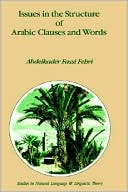

 |

|

The average rating for Issues In The Structure Of Arabic Clauses And Words based on 2 reviews is 4.5 stars.
Review # 1 was written on 2019-01-05 00:00:00 John Hayes John HayesOverall, the book is good. The analyses given in the book are formulated within the general GB framework, which makes sense given that the book was written a little while back. I like two chapters in particular: chapter one and chapter five. Chapter one gives a little synopsis of the major theories in syntax. Chapter five shows some challenging puzzles in Arabic NPs, and although I don't agree with FF on his grammatical judgment for some of the data, I found the argument very interesting and a window that might lead to proposals within modern frameworks. |
Review # 2 was written on 2016-12-26 00:00:00 Kelly Smith Kelly SmithAristotle defines. Unmercifully. And The Art of Rhetoric is no exception. Aristotle disdained the sophist tradition of ancient Greece as much as Plato, but he also understood that rhetoric was a popular study of the day and it became another discipline he sought to master. With a scientific eye and a mind toward philosophical value, Aristotle studied rhetoric as "the power to observe the persuasiveness of which any particular matter admits" (pg. 74; Ch. 1.2). Rhetoric, when used appropriately, becomes a tool of the dialectic instead of one that subverts. So begins the dissection of speech. There are three genres of rhetoric: deliberative, forensic and epideictic (display). But regardless for what purpose the rhetorician speaks, there are three components to each speech: ethos (the ethics of the speaker), pathos (the emotions of the audience) and logos (the logic of the words). What follows is a practical handbook for the orator. Part psychology, part theory part logic, The Art of Rhetoric lists considerations for the public speaker. The age of the audience, the nature of a government's citizenry and a thorough examination of the motives for various emotions fill Book II. In many ways, Book II resembles the Nicomachean Ethics in its utilitarian analysis of what drives human beings. However, Book III resembles Poetics in its methodical analysis of persuasive writing. Aristotle covers the value and pitfalls of metaphor, similes and other devices. He examines what makes "frigid" language and rhythmic speech. As with Book II, it is chocked full of examples of the good and bad. To fully appreciate The Art of Rhetoric, one must have a strong familiarity with its context. Which, quite honestly, I don't. Undoubtedly, the competing schools of rhetoric defined Athenian education and Aristotle was competing against Isocrates for students. Though most likely one of the first and most comprehensive collection of thoughts on the components of rhetoric, for the modern reader the ideas are at times dated and over generalized. The examples that Aristotle serves as benchmarks for various enthymemes (truncated syllogisms relying on commonly understood principles) are unknown to modern audiences. Likewise, his rudimentary psychological analysis of his audience is overbroad (though still impressive given his pioneering of this discipline at the time). For historical importance, this is most likely a five star work. But we have the advantage of not living in ancient Greece. In terms of enjoyment, and actual value for the modern reader, these ideas regarding communication and public speaking have been conveyed more clearly and effectively by other writers. __________________________________________________________ One interesting comparison of East/West thought can be seen by these two passages. First, Aristotle:Surely everyone would agree that one or more of these is happiness. If, then happiness is some such thing, its elements must be: Gentle birth, a wide circle of friends, a virtuous circle of friends, wealth, creditable offspring, extensive offspring and a comfortable old age; also the physical virtues (e.g. health, beauty, strength, size and competitive prowess), reputation, status, good luck and virtue…(pg. 87, Ch. 1.5, circa 4th century B.C. emphasis added) Compared to Lie Yukou, circa 5th century B.C, whose sayings were compiled in the Lieh Tzu (Liezi) in the 3rd or 4th century A.D:There are four things," states a Taoist work of this age (the Lieh Tzu: third century A.D.), "that do not allow people to have peace. The first is long life, the second is reputation, the third is rank, and the fourth is riches. Those who have these things fear ghosts, fear men, fear power, and fear punishment. They are called fugitives…(Oriental Mythology; Campbell, Joseph pg. 435) |
CAN'T FIND WHAT YOU'RE LOOKING FOR? CLICK HERE!!!